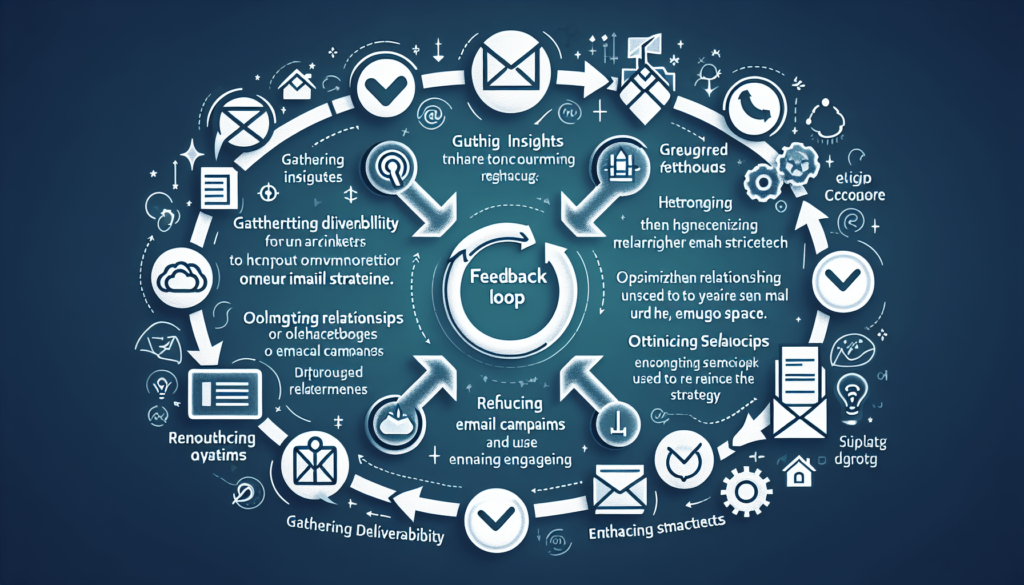Are you looking to enhance your email strategy and boost engagement with your audience? Look no further than feedback loops. Feedback loops provide valuable insights into the effectiveness of your email campaigns by collecting data on customer behavior, preferences, and responses. By analyzing this data, you can make informed decisions on how to refine and optimize your email strategy, ensuring that your messages resonate with your recipients and drive desired outcomes. In this article, we will explore the benefits of feedback loops and how they can help you improve your email strategy for better results.

Understanding Feedback Loops in Email Marketing
Email marketing is a powerful tool for businesses to connect with their audience and drive conversions. However, it is crucial to continually optimize and improve email strategies to ensure maximum effectiveness. One valuable method to enhance email marketing campaigns is through the use of feedback loops. Feedback loops provide valuable insights from subscribers by capturing and analyzing their feedback about the emails they receive. In this article, we will explore the definition, functioning, benefits, and challenges of feedback loops in email marketing, as well as best practices for utilizing them effectively.
Definition of Feedback Loops
Feedback loops, in the context of email marketing, refer to the process of receiving feedback from Internet Service Providers (ISPs) regarding subscriber engagement with emails. Subscribers have the option to report emails as spam or mark them as irrelevant, which triggers a feedback loop. This feedback helps marketers gain insight into subscriber preferences, allowing them to tailor future email campaigns to their audience’s needs.
How Feedback Loops Work in Email Marketing
Feedback loops operate by establishing a communication channel between email senders and ISPs. When a subscriber reports an email as spam or marks it as irrelevant, the ISP relays that feedback to the email sender through the feedback loop. This information enables marketers to identify problematic email subscribers, evaluate email content and engagement, and take appropriate actions to improve the overall success of their campaigns.
Benefits of Using Feedback Loops in Email Marketing
Utilizing feedback loops in email marketing can have several significant benefits for businesses:
- Reduced email complaints and spam reports: Feedback loops allow businesses to promptly address any issues that may be causing subscribers to mark their emails as spam, leading to a decrease in spam complaints and ensuring that future emails reach the inbox instead of the spam folder.
- Improved sender reputation: By actively monitoring and promptly addressing subscriber feedback through feedback loops, businesses can maintain a positive sender reputation, increasing the chances of their emails being delivered and read by subscribers.
- Higher deliverability rates and open rates: Understanding subscriber preferences and addressing their concerns through feedback loops helps marketers optimize their email content and increase engagement. This, in turn, leads to higher deliverability rates and open rates, ultimately improving the overall success of their email marketing campaigns.
Types of Feedback Loops
There are three main types of feedback loops in email marketing:
ISP Feedback Loops
ISP feedback loops are the most common type and involve the direct communication between the email sender and the Internet Service Provider. Marketers need to register their email domain with each ISP that offers feedback loops to gain access to valuable feedback from subscribers.
ISP Aggregate Feedback Loops
ISP aggregate feedback loops provide a consolidated report of subscriber feedback from multiple ISPs. Instead of receiving feedback individually from each ISP, marketers can access one comprehensive report, simplifying the analysis process and allowing for more efficient action-taking.
Private Feedback Loops
Private feedback loops are established between the email sender and specific mailbox providers or organizations. These feedback loops provide more focused insights by targeting a particular segment of a marketer’s email list, allowing for more targeted optimizations and improvements.
How to Set Up Feedback Loops
To set up feedback loops and start gathering valuable subscriber feedback, follow these steps:
Identify Email Service Providers (ESPs) That Offer Feedback Loops
Begin by identifying the ESPs that offer feedback loop functionality. Some popular ESPs that provide this feature include Gmail, Yahoo, Outlook.com, and AOL. Research and determine which ESPs align with your business’s email marketing strategy and goals.
Follow the Registration Process for Each Feedback Loop
Once you have identified the relevant ESPs, visit their websites or contact their support teams to understand the registration process for their feedback loops. Follow the provided instructions to ensure successful activation of the feedback loops for your email domain.
Authenticate Your Email Domain to Ensure Successful Feedback Loop Activation
To maximize the effectiveness of feedback loops, it is crucial to authenticate your email domain. This involves implementing various authentication methods such as Sender Policy Framework (SPF), DomainKeys Identified Mail (DKIM), and Domain-based Message Authentication, Reporting, and Conformance (DMARC). Authentication helps build trust with ISPs, ensuring that your emails are not mistaken for spam and are delivered to the inbox instead.

Analyzing Feedback Loop Data
Once feedback loops are set up and operational, it is essential to analyze the received data to derive meaningful insights. This analysis allows you to make informed decisions and take necessary actions to improve your email marketing strategy. Here are the key steps to effectively analyze feedback loop data:
Understanding Feedback Loop Reports
Feedback loop reports typically include information on the complaint rate, spam trap hits, and bounce rates. Understanding these metrics helps identify the extent of subscriber dissatisfaction and provides insights into the potential problems with your email content or subscriber list.
Identifying Problematic Email Subscribers
Feedback loop data enables businesses to identify subscribers who frequently mark emails as spam or report them as irrelevant. By identifying these problematic subscribers, you can segment them accordingly to minimize the negative impact on your campaign success and overall sender reputation.
Analyzing Trends and Patterns in Subscriber Feedback
Feedback loop data provides valuable insights into trends and patterns in subscriber feedback. Examination of these trends helps businesses identify common issues or recurring themes that may be negatively affecting their email marketing strategy. By discovering these patterns, marketers can make targeted changes to their email content and engagement strategies.
Taking Action Based on Feedback
Simply gathering feedback is not enough; taking proactive action based on the received feedback is crucial for optimizing email marketing strategies. Here are some essential actions to consider:
Segmenting Problematic Subscribers
To minimize the negative impact of problematic subscribers, consider segmenting them separately from your main email list. This allows you to tailor specific campaigns or content to this segment, potentially addressing their concerns and increasing engagement.
Adjusting Email Content and Frequency
Feedback loop data often provides insights into areas where your email content may be falling short or causing dissatisfaction. Use this feedback to adjust your email content, ensuring it aligns better with subscribers’ expectations. Additionally, consider reviewing the frequency of your emails to strike the right balance between maintaining engagement and avoiding overwhelming subscribers.
Improving Engagement and Deliverability
Taking action based on feedback should be geared towards enhancing engagement and improving deliverability. Analyze feedback loop data to determine areas where subscribers are disengaged or dissatisfaction is prevalent. Use this information to implement strategies that encourage interactivity, personalization, and valuable content, ultimately improving engagement and increasing deliverability rates.
Benefits of Feedback Loops in Email Marketing
The implementation of feedback loops in email marketing yields several notable benefits:
Reduced Email Complaints and Spam Reports
By actively addressing subscriber concerns through feedback loops, businesses can significantly reduce the number of complaints and spam reports. This leads to better overall email deliverability and ensures that more emails reach the inbox instead of being flagged as spam.
Improved Sender Reputation
Maintaining a positive sender reputation is crucial to email marketing success. Feedback loops enable businesses to promptly address any issues affecting their reputation, ultimately leading to an enhanced sender reputation and increased trust from ISPs.
Higher Deliverability Rates and Open Rates
Adopting feedback loops allows marketers to optimize their email campaigns based on subscriber feedback. By tailoring content, engagement strategies, and other elements to meet subscriber preferences, businesses can achieve higher deliverability rates and open rates. This, in turn, increases the chances of achieving desired conversions and success.
Challenges and Considerations of Feedback Loops
While feedback loops can be highly beneficial, there are some challenges and considerations to keep in mind:
Potential Delays in Feedback Loop Activation
After setting up feedback loops, there may be a delay before receiving actionable data. This can impact the speed at which issues are addressed and optimizations are implemented. Marketers should be prepared to account for this delay and use alternative methods to gather feedback during this time.
Difficulty in Identifying Specific Problematic Emails
Feedback loop data provides insights into problematic subscribers but may not specify which specific emails are causing dissatisfaction. This can make it challenging to pinpoint the exact issues and take targeted corrective actions. Additional analysis and strategies may be required to identify problematic emails accurately.
Risks of Overreacting or Underreacting to Subscriber Feedback
It is essential to strike a balance when addressing subscriber feedback. Overreacting can lead to unnecessary changes that may not reflect the preferences of the majority of subscribers. Underreacting, on the other hand, can result in the persistence of issues that hamper the success of email campaigns. Careful consideration and analysis are necessary to take relevant and effective actions based on feedback.
Best Practices for Maximizing the Value of Feedback Loops
To maximize the effectiveness and value of feedback loops, consider implementing the following best practices:
Regularly Monitor and Analyze Feedback Loop Reports
Stay proactive in monitoring and analyzing feedback loop reports to identify trends, recurring issues, and opportunities for improvement. Regular analysis allows you to stay ahead of potential problems and make data-driven decisions to enhance your email marketing strategy continually.
Maintain a Clean Email List by Promptly Removing Problematic Subscribers
Segment and remove problematic subscribers from your main email list promptly. By keeping your list clean, you ensure that future email campaigns are targeted to engaged and interested recipients, maximizing deliverability and minimizing the risk of negative subscriber feedback.
Implement Personalized Strategies to Engage and Retain Subscribers
Use the insights gained from feedback loop data to implement personalized strategies that resonate with your subscribers. Tailor your email content, engagement techniques, and offers to meet their preferences and needs. Personalization fosters stronger connections and increases the chances of subscriber engagement and long-term loyalty.
Alternative Methods to Gathering Feedback
While feedback loops provide valuable insights, they are not the only method for gathering subscriber feedback. Consider utilizing the following alternative methods to supplement your understanding of subscriber preferences and improve your email marketing strategy:
Email Engagement Metrics
Leverage email engagement metrics, such as open rates, click-through rates, and conversion rates, to gain insight into subscriber behavior and preferences. Monitoring these metrics allows you to identify areas where improvements can be made and tailor your campaigns accordingly.
Subscriber Surveys and Feedback Forms
Conduct surveys and use feedback forms to directly gather insights and opinions from your subscribers. Crafting well-designed surveys and feedback forms can provide a wealth of qualitative and quantitative information that complements the data gathered from feedback loops.
Customer Support Interactions
Regularly review and analyze customer support interactions to identify recurring themes or issues raised by subscribers. Customer support teams often have firsthand knowledge of subscriber concerns, providing valuable insights that can help shape email marketing strategies.
Conclusion
In conclusion, feedback loops play a crucial role in optimizing email marketing strategies. By actively capturing and analyzing subscriber feedback, businesses can make informed decisions, tailor their email campaigns, and improve engagement and deliverability. Through the establishment of feedback loops, businesses can reduce spam complaints, improve their sender reputation, and achieve higher open rates. While feedback loops do come with challenges and considerations, implementing best practices and utilizing alternative methods to gather feedback can maximize their value further. Remember, email marketing is an ongoing process, and continually utilizing feedback to enhance strategies will lead to long-term success in delivering impactful and engaging email campaigns.

